Guest Blogged by John Gideon of VotersUnite.Org with input from Ellen Theisen, also of VotersUnite.Org
 Now that the California Secretary of State's "Top-To-Bottom Review" testing is complete and the reports have been submitted, nearly everyone is falling over themselves to read and talk about the many startling vulnerabilities easily found by the "Red Teams" who performed hack testing on the systems.
Now that the California Secretary of State's "Top-To-Bottom Review" testing is complete and the reports have been submitted, nearly everyone is falling over themselves to read and talk about the many startling vulnerabilities easily found by the "Red Teams" who performed hack testing on the systems.
However, there is another report that has been overlooked, for the most part, by the media and the public. That is the "Accessibility Review" which examined whether the Direct Recording Electronic (DRE) voting systems meet federal requirements to allow voters with disabilities to cast their votes privately and independently as required by the Help America Vote Act (HAVA). Maybe it's because, as some have pointed out, accessibility issues are not as "sexy" as hacking into voting machines. Or maybe it's because this report is 155 pages long as compared to less than 20 pages for the "Red Team" reports. Either way, the failures found in the accessibility report may pack more dynamite and leave more questions unanswered than the security reports.
The "Executive Summary" of that report says it all:
Notice that the researchers say, "none met the accessibility requirements of current law." That's federal and state law. The machines have been sold for years --- and, in fact, the use of DRE machines as a whole has been jammed down America's polling places --- on the basis that they meet federal HAVA mandates for an accessible means of voting in every polling place. And yet, the California analysts found, they are not accessible at all...
Who decided these machines met the standards for accessibility in the first place? That would be the Independent Test Authorities (ITAs), which originally certified that the machines met the federal "Voluntary Voting System Standards." The ITAs are a small consortium of test labs, chosen and paid for by the voting machine vendors themselves. Next, the National Association of State Elections Directors (NASED) Technical Panel reviewed the ITA tests and gave their stamp of approval by pronouncing these systems "federally qualified." Yet California's report shows without a doubt that the machines do NOT meet the standards and that they should never have been qualified for use by NASED.
NOTE: Responsibility for determining federal qualification has now been fully taken over by the U.S. Elections Assistance Commission (EAC).
 After NASED's approval, the machines were again checked at the state level by private consultants who were hired by the state. The fun detail is that the same private consultants who tested and inspected the machines in question and who worked for the prior Secretary of State, Bruce McPherson, are among the people who made up the NASED Technical Panel; Paul Craft, Steve Freeman, and Kate McGregor of Freeman, Craft, McGregor Group.
After NASED's approval, the machines were again checked at the state level by private consultants who were hired by the state. The fun detail is that the same private consultants who tested and inspected the machines in question and who worked for the prior Secretary of State, Bruce McPherson, are among the people who made up the NASED Technical Panel; Paul Craft, Steve Freeman, and Kate McGregor of Freeman, Craft, McGregor Group.
These consultants were supposed to test and provide the CA Secretary of State with their opinion of whether the voting systems sold and used in the state of California met the federal and state standards. Clearly, Mr. Freeman and Mr. Craft (Ms. McGregor is the only partner not to sit on the NASED Panel, though she did carry out the approval process for the InkaVote Plus system used in Los Angeles County on behalf of that panel) overlooked a lot. From all of their "Consultants Reports" they submitted, it appears they did not actually test any of the voting machines for accessibility. Instead, it seems that they were simply presumed to be accessible, since they were being sold to counties for use by voters with disabilities.
Mr. Craft and Ms. McGregor were also the two consultants involved in the testing of the "Vote-PAD" in California. Vote-PAD is a non-computerized assistive voting device offered to California as an alternative to the expensive DRE voting systems. In the state's test of the system last year, paid for with funds from Vote-PAD, a test script was written that was totally unfair and designed to ensure failure of the Vote-PAD.
[DISCLOSURE: VotersUnite's Ellen Theisen is the inventor of the Vote-PAD.]
The difference between the tests performed on DREs by SoS Bowen and those conducted on Vote-PAD by former-SoS McPherson couldn't be clearer. The differences between the fair and unfair tests are clearly illustrated by simply comparing the two different tests. Here are a few examples:
Environment
BOWEN'S DRE TEST: A private cubicle was provided for each voter, with three video cameras filming from different angles. A test monitor was on hand to answer questions and give instructions before and after the free form voting.
MCPHERSON'S Vote-PAD TEST: Six tables were set up for voters, with one video camera on each voter. All tables were in the same open room, along with the observers, poll workers, test administrators, and visitors, milling around and talking. A test monitor sat across the table from the voter giving instructions from the script and occasionally engaging in casual conversation, banter, and even criticism of the voter.
Test Scripts
DRE Test Script:
Vote your choices and call out your selections as you make them.
If the review does not start automatically, select and start the review.
If possible, review to the first Senate race and modify your choice.
If you have not made a choice in that race, make a choice and then change it.
Go back to the first House of Representatives race and change to write-in "Joe Smith."VotePAD Test Script:
Begin voting.
Skip the third contest, and continue voting.
Vote the sixth contest as a write-in.
Return to the third contest and vote it.
Resume voting where you left off.
Vote the eighth contest as a write-in.
Vote the eleventh contest as a write-in.
Vote the sixteenth contest as a write-in.
Skip the 23rd and 24th contests, vote the 25th and 26th.
Return to the 23rd contest and vote it.
Resume voting where you left off.Accuracy
DRE Error Rate: (voluntary write-ins and one scripted write-in) 6.6%
Vote-PAD Error Rate (with voluntary write-ins only): 5.5%
(with voluntary and four scripted write-ins): 10.3%Positioning for Wheelchair Users
DREs: The VVSG requires a minimum of 30 inches of toe and knee clearance. No machine provided that clearance. This deficit posed a problem to almost every wheelchair-using voter in this study. [Note that the use of the DREs presented an accessibility obstacle for fully-sighted wheelchair users with full manual dexterity, who do not require assistance to mark a paper ballot.]
Vote-PAD: People in wheelchairs moved up to the table with ease. If the table were too low, they could place the Vote-PAD on their lap. There were no problems accessing the ballot. Positioning for wheelchair users was not mentioned in the staff report.
Interference with Wheelchair Controls and Armrests
DREs: eSlate and Diebold both interfered with the wheelchair controls.
Vote-PAD: No interference occurred with anyone’s wheelchair controls. This was not mentioned in the staff report.
Speech Volume
DREs: eSlate has an in-line volume control, difficult for voters with neuropathy. Diebold has a five-step control. Sequoia has a 10-step control. All systems’ low volume was inaudible, which does not comply with the federal standards.
Vote-PAD: Infinite steps of control. Low volume is inaudible and non-compliant with federal standards. This was not checked by the staff or mentioned in the staff report.
Voter-Verified Paper Record
DREs: Visually impaired voters were unable to verify the paper record.
Vote-PAD: Visually-impaired voters could verify their selections with the verification wand. Those who used it to verify their own votes did so successfully, even occasionally using it to find their place on the ballot during the scripted voting.
Audio Interface in Complex Tasks
DREs: “Audio interface users found the more complex tasks such as reviewing, making changes, write-in voting, verifying, and casting the ballot very confusing. Although moving from race to race and making selections is somewhat intuitive, the acts of reviewing, modifying, verifying, and casting are not.
Vote-PAD: More complex tasks are more difficult for blind voters using the Vote-PAD, though they are still intuitive. However, the staff did not distinguish between these complex tasks and the simpler task of “moving from race to race and making selections.” Thus the standard script called for 10 separate instances of moving from one place on the ballot to another and finding the corresponding place in the audio instructions.
Write-Ins
DREs: Write-ins required many keystrokes for “Joe Smith.” 103 keystrokes for the eSlate, 32 for the Diebold, 130 for the Edge. Write-ins were challenging and tedious for most of the voters.
Vote-PAD: Write-ins were difficult for visually-impaired voters, not for others. Two of the eleven pages of the staff’s testing results were devoted to discussing the difficulties of write-ins for visually-impaired voters.
Privacy
DREs: “Eavesdropping on the visual display” is a potential problem, especially for those who increase the text size on the screen.
Vote-PAD: The same privacy can be provided as is provided to any voter marking a paper ballot.
So, what is the state going to do now? The four voting systems tested, Diebold TSx, Sequoia Edge I and II, and Hart InterCivic eSlate all failed to meet the federal standards for accessibility. Unless they are upgraded to make them compliant they cannot be used to meet the mandate for an accessible voting machine in each polling place. Upgrades would first require new federal certification which could take up to 6 months after the upgrades were developed and thereafter, California state testing and certification.
Clearly none of the DRE systems tested can be ready by Nov. 2007 and possibly not even Nov. 2008. Perhaps Secretary of State Bowen would serve the voters of her state well by using the same script that was used for the four DREs on the Vote-PAD, so that it has a fair test. If it passes, she could then certify the Vote-PAD for use by disabled voters in compliance with the law.


 How (and Why!) to 'Extend an Olive Branch' to MAGA Family Members Over the Holidays: 'BradCast' 11/21/24
How (and Why!) to 'Extend an Olive Branch' to MAGA Family Members Over the Holidays: 'BradCast' 11/21/24 'Green News Report' 11/21/24
'Green News Report' 11/21/24
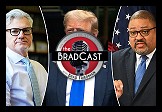 Former Federal Prosecutor: Trump Must Be Sentenced in NY Before Taking Office Again: 'BradCast' 11/20/24
Former Federal Prosecutor: Trump Must Be Sentenced in NY Before Taking Office Again: 'BradCast' 11/20/24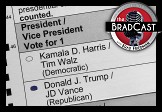 'Bullet Ballot' Claims, Other Arguments for Hand-Counting 2024 Battleground Votes: 'BradCast' 11/19/24
'Bullet Ballot' Claims, Other Arguments for Hand-Counting 2024 Battleground Votes: 'BradCast' 11/19/24 'Green News Report' 11/19/24
'Green News Report' 11/19/24 Trump Already Violating Law (He Signed!) During Transition: 'BradCast' 11/18/24
Trump Already Violating Law (He Signed!) During Transition: 'BradCast' 11/18/24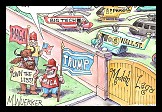 Sunday 'Into the Gaetz of Hell' Toons
Sunday 'Into the Gaetz of Hell' Toons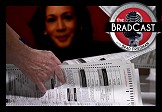 Computer Security Experts Ask Harris to Seek Hand-Counts Due to Voting System Breaches: 'BradCast' 11/14/24
Computer Security Experts Ask Harris to Seek Hand-Counts Due to Voting System Breaches: 'BradCast' 11/14/24  'Green News Report' 11/14/24
'Green News Report' 11/14/24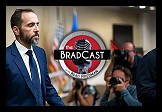 Trump Criminal Cases Fade After Election as GOP 'Does Not Believe in Rule of Law': 'BradCast' 11/13/24
Trump Criminal Cases Fade After Election as GOP 'Does Not Believe in Rule of Law': 'BradCast' 11/13/24 Climate Advocates Brace for Fight With Trump 2.0: 'BradCast' 11/12/24
Climate Advocates Brace for Fight With Trump 2.0: 'BradCast' 11/12/24 'Green News Report' 11/12/24
'Green News Report' 11/12/24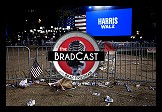 Let It All Out: 'BradCast' 11/11/24
Let It All Out: 'BradCast' 11/11/24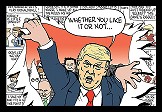 Sunday 'Like it or Not' Toons
Sunday 'Like it or Not' Toons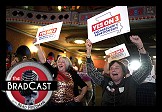 Not All Bad: Abortion Rights Won Big (Almost) Everywhere: 'BradCast' 11/7/24
Not All Bad: Abortion Rights Won Big (Almost) Everywhere: 'BradCast' 11/7/24 'Green News Report' 11/7/24
'Green News Report' 11/7/24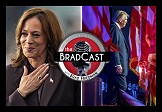 U.S. CHOOSES CONVICTED CRIMINAL, ADJUDICATED RAPIST: 'BradCast' 11/6/24
U.S. CHOOSES CONVICTED CRIMINAL, ADJUDICATED RAPIST: 'BradCast' 11/6/24 ELECTION DAY 2024: Tea Leaves, Probs for Voters, What's Next: 'BradCast' 11/5/24
ELECTION DAY 2024: Tea Leaves, Probs for Voters, What's Next: 'BradCast' 11/5/24 'Closing Arguments' for Undecideds, Third-Party Voters: 'BradCast' 11/4/24
'Closing Arguments' for Undecideds, Third-Party Voters: 'BradCast' 11/4/24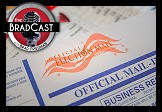 The GOP 'Voter Fraud' Before the Storm: 'BradCast' 10/31/24
The GOP 'Voter Fraud' Before the Storm: 'BradCast' 10/31/24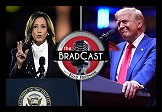 'Closing Arguments'with Digby and Driftglass: 'BradCast' 10/30/24
'Closing Arguments'with Digby and Driftglass: 'BradCast' 10/30/24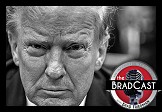 Trump Promises to be a Lawless, Authoritarian President. Believe Him: 'BradCast' 10/29/24
Trump Promises to be a Lawless, Authoritarian President. Believe Him: 'BradCast' 10/29/24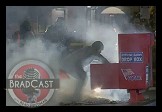 Ballots Burn, Billion-aires 'Obey in Advance', Callers Ring In: 'BradCast' 10/28/24
Ballots Burn, Billion-aires 'Obey in Advance', Callers Ring In: 'BradCast' 10/28/24 Musk's Privatized Internet Satellite System Threatens U.S. National Security
Musk's Privatized Internet Satellite System Threatens U.S. National Security
 VA GOP VOTER REG FRAUDSTER OFF HOOK
VA GOP VOTER REG FRAUDSTER OFF HOOK Criminal GOP Voter Registration Fraud Probe Expanding in VA
Criminal GOP Voter Registration Fraud Probe Expanding in VA DOJ PROBE SOUGHT AFTER VA ARREST
DOJ PROBE SOUGHT AFTER VA ARREST Arrest in VA: GOP Voter Reg Scandal Widens
Arrest in VA: GOP Voter Reg Scandal Widens ALL TOGETHER: ROVE, SPROUL, KOCHS, RNC
ALL TOGETHER: ROVE, SPROUL, KOCHS, RNC LATimes: RNC's 'Fired' Sproul Working for Repubs in 'as Many as 30 States'
LATimes: RNC's 'Fired' Sproul Working for Repubs in 'as Many as 30 States' 'Fired' Sproul Group 'Cloned', Still Working for Republicans in At Least 10 States
'Fired' Sproul Group 'Cloned', Still Working for Republicans in At Least 10 States FINALLY: FOX ON GOP REG FRAUD SCANDAL
FINALLY: FOX ON GOP REG FRAUD SCANDAL COLORADO FOLLOWS FLORIDA WITH GOP CRIMINAL INVESTIGATION
COLORADO FOLLOWS FLORIDA WITH GOP CRIMINAL INVESTIGATION CRIMINAL PROBE LAUNCHED INTO GOP VOTER REGISTRATION FRAUD SCANDAL IN FL
CRIMINAL PROBE LAUNCHED INTO GOP VOTER REGISTRATION FRAUD SCANDAL IN FL Brad Breaks PA Photo ID & GOP Registration Fraud Scandal News on Hartmann TV
Brad Breaks PA Photo ID & GOP Registration Fraud Scandal News on Hartmann TV  CAUGHT ON TAPE: COORDINATED NATIONWIDE GOP VOTER REG SCAM
CAUGHT ON TAPE: COORDINATED NATIONWIDE GOP VOTER REG SCAM CRIMINAL ELECTION FRAUD COMPLAINT FILED AGAINST GOP 'FRAUD' FIRM
CRIMINAL ELECTION FRAUD COMPLAINT FILED AGAINST GOP 'FRAUD' FIRM RICK SCOTT GETS ROLLED IN GOP REGISTRATION FRAUD SCANDAL
RICK SCOTT GETS ROLLED IN GOP REGISTRATION FRAUD SCANDAL VIDEO: Brad Breaks GOP Reg Fraud Scandal on Hartmann TV
VIDEO: Brad Breaks GOP Reg Fraud Scandal on Hartmann TV RNC FIRES NATIONAL VOTER REGISTRATION FIRM FOR FRAUD
RNC FIRES NATIONAL VOTER REGISTRATION FIRM FOR FRAUD EXCLUSIVE: Intvw w/ FL Official Who First Discovered GOP Reg Fraud
EXCLUSIVE: Intvw w/ FL Official Who First Discovered GOP Reg Fraud GOP REGISTRATION FRAUD FOUND IN FL
GOP REGISTRATION FRAUD FOUND IN FL


































